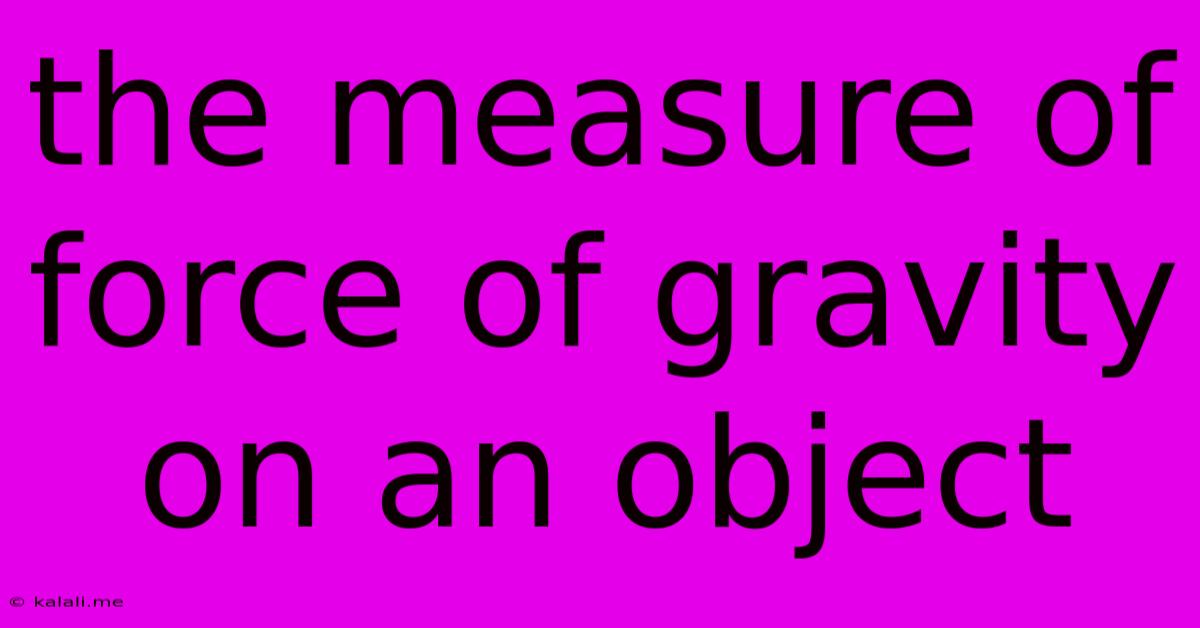The Measure Of Force Of Gravity On An Object
Kalali
Jun 14, 2025 · 3 min read

Table of Contents
Understanding the Measure of Gravity's Force on an Object: Weight and Mass Explained
This article explores the fundamental concept of how gravity affects objects, focusing on the key difference between mass and weight, and how to calculate the force of gravity. Understanding these concepts is crucial in various fields, from basic physics to advanced aerospace engineering. We'll delve into the calculations and explore real-world applications.
What is Gravity?
Gravity is a fundamental force of nature that attracts any two objects with mass towards each other. The more massive the objects, the stronger the gravitational pull. The distance between the objects also plays a crucial role; the farther apart they are, the weaker the gravitational force. On Earth, we experience gravity primarily as the force pulling us towards the planet's center.
Mass vs. Weight: A Crucial Distinction
Many people use the terms "mass" and "weight" interchangeably, but they represent distinct physical quantities:
-
Mass: Mass is a measure of the amount of matter in an object. It's an intrinsic property and remains constant regardless of location. We typically measure mass in kilograms (kg).
-
Weight: Weight, on the other hand, is the force of gravity acting on an object's mass. It's a force, measured in Newtons (N), and varies depending on the strength of the gravitational field. For example, an astronaut's mass remains the same on the Moon, but their weight is significantly less due to the Moon's weaker gravitational pull.
Calculating the Force of Gravity (Weight)
The force of gravity on an object, also known as its weight, can be calculated using Newton's Law of Universal Gravitation:
F = G * (m1 * m2) / r²
Where:
- F represents the force of gravity (weight) in Newtons (N).
- G is the gravitational constant, approximately 6.674 x 10⁻¹¹ N⋅m²/kg².
- m1 is the mass of the first object (e.g., the Earth).
- m2 is the mass of the second object (e.g., a person or an apple).
- r is the distance between the centers of the two objects.
Simplified Calculation for Objects Near the Earth's Surface
For objects near the Earth's surface, we can use a simplified formula, as the distance 'r' is relatively constant:
W = m * g
Where:
- W is the weight in Newtons (N).
- m is the mass of the object in kilograms (kg).
- g is the acceleration due to gravity, approximately 9.81 m/s² on Earth. This value can vary slightly depending on location and altitude.
Examples
Let's illustrate with examples:
-
Example 1: A 70 kg person on Earth. Their weight is approximately W = 70 kg * 9.81 m/s² = 686.7 N.
-
Example 2: A 1 kg apple on Earth. Its weight is approximately W = 1 kg * 9.81 m/s² = 9.81 N.
Factors Affecting the Force of Gravity
Several factors influence the force of gravity experienced by an object:
- Mass of the object: A more massive object experiences a stronger gravitational force.
- Mass of the celestial body: A more massive planet (like Jupiter) exerts a stronger gravitational pull than a smaller planet (like Mars).
- Distance from the center of the celestial body: Gravity weakens with distance; the farther an object is from the center of a planet, the weaker the gravitational force.
Conclusion
Understanding the measure of gravity's force on an object involves grasping the difference between mass and weight and applying the appropriate formulas. While Newton's Law of Universal Gravitation provides a comprehensive calculation, the simplified formula using acceleration due to gravity is sufficient for most everyday applications on Earth. This knowledge is fundamental to comprehending various physical phenomena and engineering challenges.
Latest Posts
Latest Posts
-
Why Do We Need A Constitution
Jun 14, 2025
-
Which Of The Following Statements Regarding Radioactive Decay Is True
Jun 14, 2025
-
All Of The Following Are Barriers To Effective Communication Except
Jun 14, 2025
-
Which Of The Following Is A Function Of Money
Jun 14, 2025
-
What Is The Difference Between A Square And A Rhombus
Jun 14, 2025
Related Post
Thank you for visiting our website which covers about The Measure Of Force Of Gravity On An Object . We hope the information provided has been useful to you. Feel free to contact us if you have any questions or need further assistance. See you next time and don't miss to bookmark.